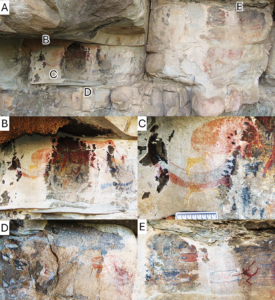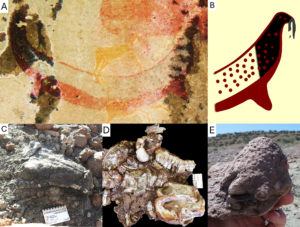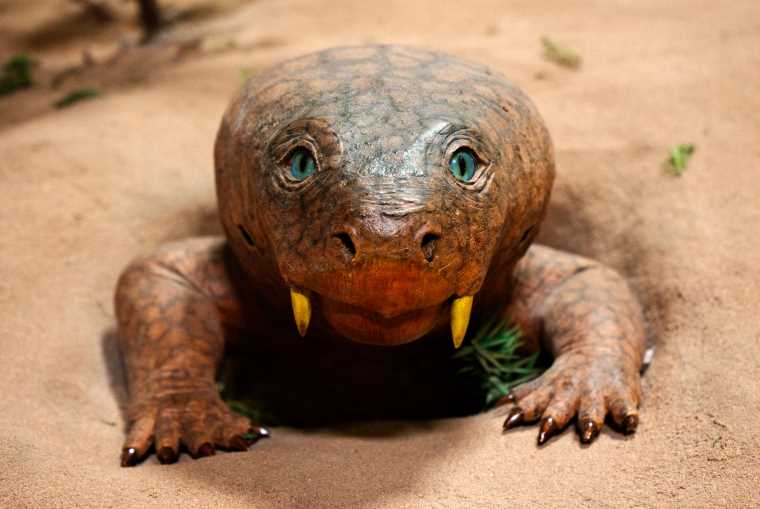A 200-year-old South African cave painting made by the region’s first inhabitants, the San people, appears to depict an animal that has been extinct for over 200 million years. A long-bodied animal with downward-turned tusks, the warm-blooded, lizard-like creature called a dicynodont (two-toothed dog) roamed the area before the first dinosaur appeared and died off at the end of the Triassic.
If the artwork from the cave’s Horned Serpent panel at La Belle France (Free State Province, South Africa) is of this extinct species, its creation would predate the first known scientific classification of a dicynodont by at least a decade. The painting would also confirm the belief that the San people incorporated the fossils of extinct animals around them into their culture, mythology, and artistic expressions.
“This work supports that the first inhabitants of southern Africa, the San hunter-gatherers, discovered fossils, interpreted them, and integrated them in their rock art and belief system,” explained Julien Benoit of the University of the Witwatersrand, Johannesburg, South Africa, and the study’s lead researcher.
Significance of 200-Year-Old South African Cave Painting
In their published study, the researchers note that the 200-year-old South African cave painting depicts an animal with two tusks, “making it superficially look like a walrus.” However, when describing the significance of the painting, Benoit and colleagues point out that the animal depicted in the painting does not match any known modern species that live in the area.


Still, the broader region, known as the Karoo Basin, is well known for the abundance of ancient animal fossils. Among the most common fossils is a tusked animal scientists call a dicynodont, many of which can be found simply eroding from the ground.


According to the study authors, “Given the wealth of fossils that the Main Karoo Basin and other Karoo-aged basins have delivered, and the long human occupation of this part of the African continent, the existence of a long-standing indigenous knowledge of fossils is very likely.” Still, finding a 200-year-old South African cave painting that appears to depict one of these long-extinct animals offered that idea significantly more credence.
If the painting represents the San people’s interpretation of the dicynodont fossil, it may also prove to be scientifically significant, as the art depicted on the Horned Serpent panel dates to sometime between 1821 and 1835. That date would make this the first depiction of a dicynodont by at least a decade.
“The painting was made in 1835 at the latest,” Benoit said, “which means this dicynodont was depicted at least ten years before the western scientific discovery and naming of the first dicynodont by Richard Owen in 1845.”
Creatures From the San “Spirit Realm” Likely Based on Real Animals
Critics of the connection to an actual animal contend that the painting merely represents a rain animal from the San “spirit realm,” “which is spiritual by essence and does not have to be realistic.” While the researchers concede that artistic depictions of fictional tusked animals appear throughout the region, that fact still does not directly address where that mythological creature came from in the first place.
“Even if one considers that the Horned Serpent panel has a purely spiritual meaning, it does not invalidate the hypothesis that the tusked animal itself may have been imagined based on a dicynodont fossil,” they write. “The spiritual and palaeontological interpretation of this painting are not mutually exclusive.”


The team says that “even the most fantastic elements” of the artwork made by the San people, including purely fictitious inventions, are regularly based on “actual animals and phenomena.”
“The San spiritual pantheon is directly inspired from their real-life environment, and the fantastic beings they painted are thus always an amalgamation of different existing animals,” they explain,
The researchers also believe these 200-year-old South African cave paintings have one key component that makes it likely they were representations of an actual animal fossil and not a wholly mythological creation.
“Tusked creatures (more or less imaginary and composite) are not rare in San rock art, including tusked lion, snake, antelopes, and people,” they write, “but in those cases, the tusks are always curved upwards, like they do in warthogs and bushpigs not downwards as in the tusked animal from La Belle France.”
Growing Record of Geomyths Expanding Indigenous Knowledge
The researchers say the cave painting represents just a small part of the region’s scientific and cultural wealth, and many more discoveries of this type may be waiting to be made. Unfortunately, they note that “the study of African Indigenous palaeontology is still fairly young, and the evidence remains accordingly sparse and debatable, especially given the scarcity of written accounts.”
Moving forward, the team says that further research into indigenous cultures and their artistic expressions may offer more insights into how or why ancient cultures incorporate the fossils of long-dead animals into their overall belief system. Fortunately, the research team says that those efforts are already underway, with much of it supporting the idea that indigenous societies like the San people incorporated extinct animals like the dicynodont into their broader culture.
“Although patchy, a growing record of geomyths, place names, written accounts, and archaeological evidence supports that many southern African cultures knew and, in some cases, inquired about the fossils around them,” they write.
The study “A possible later Stone Age painting of a dicynodont (Synapsida) from the South African Karoo” was published in PLoS ONE.
Christopher Plain is a Science Fiction and Fantasy novelist and Head Science Writer at The Debrief. Follow and connect with him on X, learn about his books at plainfiction.com, or email him directly at christopher@thedebrief.org.

